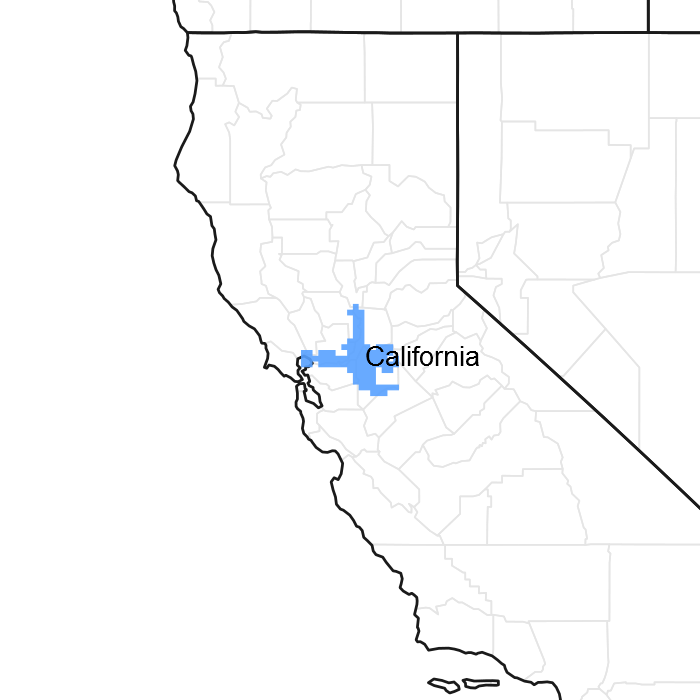
Natural Resources
Conservation Service
Ecological site R016XA001CA
Tidally-Influenced, Freshwater
Accessed: 12/21/2025
General information
Provisional. A provisional ecological site description has undergone quality control and quality assurance review. It contains a working state and transition model and enough information to identify the ecological site.

Figure 1. Mapped extent
Areas shown in blue indicate the maximum mapped extent of this ecological site. Other ecological sites likely occur within the highlighted areas. It is also possible for this ecological site to occur outside of highlighted areas if detailed soil survey has not been completed or recently updated.
MLRA notes
Major Land Resource Area (MLRA): 016X–California Delta
MLRA 16 – California Delta
Most of this area is in the California Trough Section of the Pacific Border Province of the Pacific Mountain System. A small part at the west edge of the area is in the California Coast Ranges Section of the same province and division. This MLRA was originally the conjoined flood plain along the Sacramento and San Joaquin Rivers. As sediment from these rivers built up in San Pablo Bay, a delta formed, creating many streams that divide this nearly level area into “islands.” Strong levees and drainage systems are needed to protect the islands from flooding. Elevation of the islands ranges from below sea level to slightly above sea level. This area is underlain by interbedded marine, estuarine, and fine-grained non-marine sediments transported to the delta by the Sacramento and San Joaquin Rivers as they flowed into San Pablo Bay. As the sediments built up, a delta formed and freshwater mixed with brackish water in marshes and on flood plains. As the marsh vegetation became covered with new sediments, the organic matter content in the soils built up to very high levels. When drained and exposed to the air, these peaty soils oxidize and shrink and then subside.
Land resource unit (LRU) XA is influenced primarily by freshwaters fed from the Sierra Nevada watershed snow melts and rains, however in a large portion of the LRU it is still influenced heavily by the Delta tides.
Classification relationships
Using the December 2010 draft EPA ecoregion level IV: 7j, Delta polygon mostly closely overlaps with MLRA 16.
MLRA 16 mostly aligns with the USFS (1997) ecological subsection 262AI, Great Valley, Delta.
Ecological site concept
This site is a patchwork of freshwater water-obligate and facultative wet plant communities influenced by the ocean tides. It is found in the lowest positions on the landscape within the LRU and it's primary water sources come from the Sierra Nevada watersheds, consisting of snow melt and rains.
Soils are fine-textured, thermic histosols and cumulic mollisols with poor to very poor drainage. Salinity is limited and should not affect vegetation response; however there will be some mixing of ocean waters in parts of the ecological site that are closer to the western edge.
It is dominated by vegetation that is adaptable to changing water levels and anaerobic soils conditions, primary species consist of Schoenoplectus species, Eleocharis spp., and in some areas Salix spp. Patches where there are less lengthy periods of anaerobic conditions.
This site has extremely fertile soils and the histosols can very quickly lose their organic properties when either drained or suffering lengthy droughts. Therefore much of this ecological site has been converted to agriculture and altered significantly.
Salinity is relatively high and will have significant impacts on vegetation and management response.
Associated sites
| R016XA002CA |
Freshwater, Stratified, Fluventic 016XA002 occurs on natural levees primarily in the northern half of the LRU. |
|---|---|
| R016XA004CA |
Island Sandhills 016XA004 occurs on mineral soils on ancient sand dunes near Oakley CA. |
| R016XB001CA |
Tidally-Influenced, Salt-Affected 016XB001 are organic soils more heavily influenced by salt water from tides as occurring most extensively in Suisun Bay and supporting more saline-adapted species. |
Similar sites
| R016XB001CA |
Tidally-Influenced, Salt-Affected 016XB001 appears to be a less productive site which following improvement for production agriculture favors salt tolerant species such as saltgrass and Phragmites. |
|---|
Table 1. Dominant plant species
| Tree |
Not specified |
|---|---|
| Shrub |
(1) Salix |
| Herbaceous |
(1) Schoenoplectus acutus |
Click on box and path labels to scroll to the respective text.
